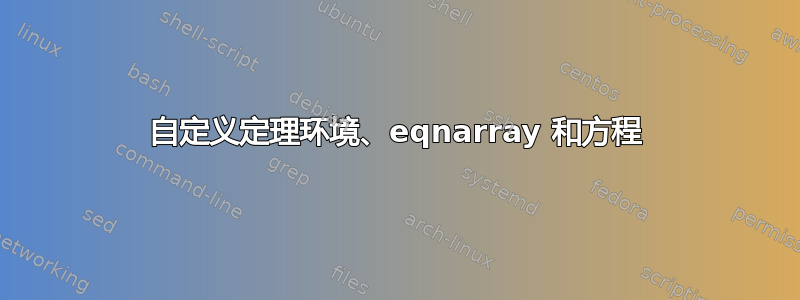
在我的论文中,我几乎总是使用以下环境:equation,eqnarray以及在序言中使用命令定义的环境\newtheorem(即,,,definition等等)。themeTheoremaproposition
但我想按如下方式定制这些环境:
对所有这些 XYZ 类型的环境进行统一编号,其中 x =“章节编号”,y =“节编号”,z =“小节编号”
编号保留在右侧环境的左侧,而不是我提到的这些环境的名称。例如:
**“XYZ 定理” xxxxxxxxxxxxxxxxxxxxxxxxxxxxxxxxxxxxxxxxxxxxxxxxxxxxxx xxxxxxxxxxxxxxxxxxxxxxxxxxxxxxxxxxxxxxxxxxxxxxxxxxxxxxxxxxxxxxxxxxxxxxxx
(XY(Z+1)) 方程 = 方程
XY(Z+2) 定义 XXXXXXXXXXXXXXXXXXXXXXXXXXXXXXXXXXXXXXXXXXXXXXXXXXXX XXXXXXXXXXXXXXXXXXXXXXXXXXXXXXXXXXXXXXXXXXXXXXXXXXXX**
不要丢失命令定义的环境之前或之后的自动间距
\newtheorem(即,,,definition等等...... )themeTheoremaproposition没有丢失命令定义的斜体字体环境
\newtheorem(即,,,definition等等...... )themeTheoremaproposition环境 comflito 中没有出现什么
enumerate。我可以在这些环境的序言中设置字体。
答案1
您可以通过定义共享计数器的类定理环境来获取序列号equation;定理头左侧的数字可以通过\swapnumbers(包amsthm)获取:
\documentclass[a4paper]{book}
\usepackage[leqno]{amsmath}
\usepackage{amsthm}
\swapnumbers
\numberwithin{equation}{section}
\newtheorem{theorem}[equation]{Theorem}
\newtheorem{definition}[equation]{Definition}
\begin{document}
\mainmatter
\chapter{Title}
\section{Title}
Some text.
\begin{theorem}
A theorem
\end{theorem}
Some text and an equation
\begin{equation}
1+1=2
\end{equation}
\begin{definition}
A definition.
\end{definition}
Some final text.
\end{document}

答案2
正如评论中提到的,您应该避免eqnarray使用amsmath包中的某些内容,例如align;参见eqnarray 与 align了解如何开始的详细信息。
\numberwithin您请求的编号约定可以通过结合包amsmath(希望您现在加载以便可以避免eqnarray!)和包\swapnumbers来实现amsthm。

您可以使用包中指定的格式自定义类定理环境的字体amsthm,如文档第 4.3 节中所述

这里有一个完整的 MWE 供您参考 - 请注意还有其他定理包可用,例如ntheorem。
\documentclass{report}
\usepackage{lipsum} % sample text
\usepackage{amsthm} % for theorems
\usepackage{amsmath}% for mathematical environments
\swapnumbers
\newtheorem{definition}{Definition}
\numberwithin{definition}{section}
\begin{document}
\chapter{}
\section{Section}
\begin{definition}
\lipsum[1]
\end{definition}
\end{document}
答案3
确实不要使用
eqnarray。检查amsmath包装。至于定理:你可能需要检查一下
amsthm包或ntheorem包(也请查看此处:http://ctan.org/keyword/theorems)。


